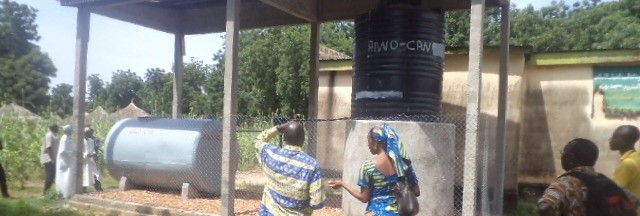Springs and wells are the most common because these are relatively inexpensive compared to boreholes which are more resilient to climate change but present the challenge of frequent breakdown due to lack of preventive maintenance of the pumps. However, the use of springs and wells present two major challenges: high fluoride concentrations in some localities and vulnerability to climate change (early and prolonged dry up during the dry season). The later imposes severe constraints especially on women and girls who are the fore of household water chore. Women and girls noted that they usually cover 5-6 km to fetch water of doubtful quality.
Action taken
Rain water harvesting and banking interventions have been implemented to provide temporal relief to the communities especially during the last three months of the dry season when all other water sources in the area have dried up. Rationing of the available water is integrated to ensure equity to the different households. In 1995, a Rock Surface Rain Water Harvesting system was constructed by CARE Cameroon in Gougouling in North Cameroon. The reservoir was designed to supply water to the population for 3 months (for details on operation see detailed case).
The African Indigenous Women’s Organization - Central African Network (AIWO-CAN) has also implemented a six domestic roof top water harvesting system in the localities of Douroum and Mbozo. Three sites in Mbozo were completed in 2012 before the end of the rainy season and have been harvesting water, while that of Douroum has been operational since completion after the 2013 rainy season.
Outcomes
With the completion of the project, communities have observed the availability of water for multiple uses: for prayers during Ramadan; for socio-cultural events in the communities as well as satisfying the drinking water needs of passer-by. Communities have reported an increase in the rate of school attendance by children as an outcome of less time spent fetching water. Water quality testing results (physic chemical) suggest that the harvest water is potable.
This project has contributed to cross cutting objectives: build community-level adaptive capacity, reduce the risks faced by communities from climate change, and in turn influence the policy and institutional arenas to promote sustainable management of water resources to counter likely climate change impacts.
Lessons learnt
• A holistic development approach rooted in IWRM is needed to address the sudano-sahelien communities’ vulnerability to climate change. The provision of basic amenities and facilities such as road infrastructure, schools, health facilities, electricity and a grinding mill to reduce the time needed to travel to mill cereals which are the staple diet of the region are important development drivers with potential to reduce deforestation and promote catchment protection and management. Considering the role of local municipalities in the provision of water to communities, their active involvement to provide technical backstopping is essential for the purpose of sustainability.
• A constituted water management committee with mechanisms for improved revenue management is essential. The absence (temporal or permanent) of a committee’s member should not be an obstacle to access to finances for operation and maintenance.
Importance for IWRM
• Provision of domestic water supply alone will not result in significant and sustained reduction in the vulnerability of the community to climate change. Multiple use services approach that guarantees water security has to be promoted for improved access to water to be affective as an adaptation measure to climate change. In rural parts of northern Cameroon, water is needed for uses like irrigation, animal production, and fisheries. To ensure water security, springs and wells need to be permanent in the long term. This will require enhancing ground water recharge which in turn reduces runoff and hence reduces soil erosion.
• While this intervention provides lessons for temporal relief, the scope of the project, the limited per capita water provided and the cost of the intervention suggest that this is not a scalable initiative from an economic stand point as well as operation and maintenance.
• This case demonstrates the need for active monitoring and evaluation (M&E) in IWRM interventions aimed at reducing vulnerability to climate change. It further makes a case for an ‘IWRM discovery and innovative funds’ that could allow ‘testing new initiatives’ for climate change and water adaptation.
• Finally, lessons learned through M&E can play a key role in informing and influencing ‘adaptive interventions’ as seen in the on-going solar pump boreholes intervention in northern Cameroon.
Key document consulted: Water harvesting as an adaptation to climate change in north Cameroon: domestic rainwater harvesting systems – Final Report for Contract # 008/15/GWP-CAf/Core submitted by Prof. Mathias Fru FONTEH, December 2013.

